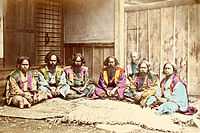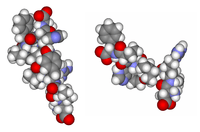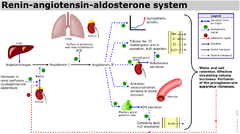Angiotensinogen core promoter element

Angiotensinogen core promoter element 1 (AGCE1) is an example of a core promoter element that may occur in a DNA sequence for only one gene (the human angiotensinogen gene angiotensin).
Proofs of concept
For the original research project focused on the transcription of A1BG, proof of concept may be simply that AGCE1 occurs in the core promoter.
Core promoters
The core promoter is the minimal portion of the promoter required to properly initiate gene transcription. It contains a binding site for RNA polymerase (RNA polymerase I, RNA polymerase II, or RNA polymerase III). Any specific gene’s core promoter is ultimately targeted by a vast network of regulatory factors that contribute to the initiation of transcription by RNA polymerase.
AGCE1 can occur upstream from -25 to -1 base pairs (bp)s of the transcription start site.[1]
Consensus sequences
The consensus sequence is 3'-A/C-T-C/T-5'.[1] By convention, this is 5'-MTY-3' on the mRNA, with T replaced by uracil (U).
The core nucleotides for AGCE1 include 3'-A/C-T-C/T-G-T-G-5', "located between the TATA box and transcription initiation site (positions −25 to −1) is an authentic regulator of human AG transcription."[2]
Human genes
"[T]he core promoter element 1 (AGCE1) of the human angiotensinogen gene (AGT) ... acts as a critical regulator of AGT transcription".[1] GeneID: 183 angiotensinogen (serpin peptidase inhibitor, clade A, member 8) [ Homo sapiens ] has the official symbol AGT.[3]
Gene transcriptions
Within the variation allowed by the consensus sequence, it is likely that the transcriptional activities of an E-box-like motif of two juxtaposed AGCE1 elements have the following ratios: "CTC/CTC and ATC/ATC homozygotes or the CTC/ATC heterozygotes are 2.5 times higher than that of the ATT/ATT homozygote and that the CTC/ATT and ATC/ATT heterozygotes are 1.75 times higher than that of the ATT/ATT homozygote."[2]
Angiotensinogen


"Angiotensinogen is an α-2-globulin produced constitutively and released into the circulation mainly by the liver. It is a member of the serpin family, although it is not known to inhibit other enzymes, unlike most serpins. Plasma angiotensinogen levels are increased by plasma corticosteroid, estrogen, thyroid hormone, and angiotensin II levels."[4]
"Angiotensin I ([CAS registry number] CAS# 11128-99-7) is formed by the action of renin on angiotensinogen. ... Renin cleaves the peptide bond between the leucine (Leu) and valine (Val) residues on angiotensinogen, creating the ten-amino acid peptide (des-Asp) angiotensin I ... Angiotensin I is converted to angiotensin II (AII) through removal of two C-terminal residues by the enzyme angiotensin-converting enzyme (ACE, or kinase)"[4].
Gene transcriptions/A1BG
An AGCE1 occurs at 3'-ATC-5', in the nucleotides before the transcription start site for the transcription of A1BG, which ends 5 bp upstream from the TSS and is the only AGCE1 within -25 and -1 bp of the TSS. Usually, the AGCE1 spans -20 to -18 bp, when a TATA box is present.[1]
However, for the transcription of A1BG, there is no TATA box and the core nucleotides 3'-GTG-5' do not occur on either side of 3'-ATC-5'.
Research
Hypothesis:
- AGCE1 does not participate in the transcription of A1BG.
Control groups

The findings demonstrate a statistically systematic change from the status quo or the control group.
“In the design of experiments, treatments [or special properties or characteristics] are applied to [or observed in] experimental units in the treatment group(s).[5] In comparative experiments, members of the complementary group, the control group, receive either no treatment or a standard treatment.[6]"[7]
Proof of concept
Def. a “short and/or incomplete realization of a certain method or idea to demonstrate its feasibility"[8] is called a proof of concept.
Def. evidence that demonstrates that a concept is possible is called proof of concept.
The proof-of-concept structure consists of
- background,
- procedures,
- findings, and
- interpretation.[9]
See also
References
- 1 2 3 4 Noriyuki Sato; Tomohiro Katsuya; Hiromi Rakugi; Seiju Takami; Yukiko Nakata; Tetsuro Miki; Jitsuo Higaki; Toshio Ogihara (September 1997). "Association of Variants in Critical Core Promoter Element of Angiotensinogen Gene With Increased Risk of Essential Hypertension in Japanese". Hypertension 30 (3 Pt 1): 321-5. doi:10.1161/01.HYP.30.3.321. PMID 9314411. http://www.ncbi.nlm.nih.gov/pubmed/9314411. Retrieved 2012-02-20.
- 1 2 Kazuyuki Yanai, Tomoko Saito, Keiko Hirota, Hideyuki Kobayashi, Kazuo Murakami and Akiyoshi Fukamizu (28 November 1997). "Molecular Variation of the Human Angiotensinogen Core Promoter Element Located between the TATA Box and Transcription Initiation Site Affects Its Transcriptional Activity". The Journal of Biological Chemistry 272 (48): 30558-62. PMID 9374551. http://www.jbc.org/cgi/pmidlookup?view=long&pmid=9374551. Retrieved 2012-02-20.
- ↑ HGNC (February 7, 2013). "AGT angiotensinogen (serpin peptidase inhibitor, clade A, member 8) [ Homo sapiens ]". 8600 Rockville Pike, Bethesda MD, 20894 USA: National Center for Biotechnology Information, U.S. National Library of Medicine. Retrieved 2013-02-10.
- 1 2 "Angiotensin, In: Wikipedia". San Francisco, California: Wikimedia Foundation, Inc. April 24, 2012. Retrieved 2012-05-21.
- ↑ Klaus Hinkelmann, Oscar Kempthorne (2008). Design and Analysis of Experiments, Volume I: Introduction to Experimental Design (2nd ed.). Wiley. ISBN 978-0-471-72756-9. http://books.google.com/?id=T3wWj2kVYZgC&printsec=frontcover.
- ↑ R. A. Bailey (2008). Design of comparative experiments. Cambridge University Press. ISBN 978-0-521-68357-9. http://www.cambridge.org/uk/catalogue/catalogue.asp?isbn=9780521683579.
- ↑ "Treatment and control groups, In: Wikipedia". San Francisco, California: Wikimedia Foundation, Inc. May 18, 2012. Retrieved 2012-05-31.
- ↑ "proof of concept, In: Wiktionary". San Francisco, California: Wikimedia Foundation, Inc. November 10, 2012. Retrieved 2013-01-13.
- ↑ Ginger Lehrman and Ian B Hogue, Sarah Palmer, Cheryl Jennings, Celsa A Spina, Ann Wiegand, Alan L Landay, Robert W Coombs, Douglas D Richman, John W Mellors, John M Coffin, Ronald J Bosch, David M Margolis (August 13, 2005). "Depletion of latent HIV-1 infection in vivo: a proof-of-concept study". Lancet 366 (9485): 549-55. doi:10.1016/S0140-6736(05)67098-5. http://www.ncbi.nlm.nih.gov/pmc/articles/PMC1894952/. Retrieved 2012-05-09.
Further reading
- Noriyuki Sato; Tomohiro Katsuya; Hiromi Rakugi; Seiju Takami; Yukiko Nakata; Tetsuro Miki; Jitsuo Higaki; Toshio Ogihara (September 1997). "Association of Variants in Critical Core Promoter Element of Angiotensinogen Gene With Increased Risk of Essential Hypertension in Japanese". Hypertension 30 (3 Pt 1): 321-5. doi:10.1161/01.HYP.30.3.321. PMID 9314411. http://www.ncbi.nlm.nih.gov/pubmed/9314411. Retrieved 2012-02-20.
External links
- African Journals Online
- Bing Advanced search
- GenomeNet KEGG database
- Google Books
- Google scholar Advanced Scholar Search
- Home - Gene - NCBI
- JSTOR
- Lycos search
- NASA's National Space Science Data Center
- NCBI All Databases Search
- Office of Scientific & Technical Information
- PsycNET
- PubChem Public Chemical Database
- Questia - The Online Library of Books and Journals
- SAGE journals online
- Scirus for scientific information only advanced search
- SpringerLink
- Taylor & Francis Online
- WikiDoc The Living Textbook of Medicine
- Wiley Online Library Advanced Search
- Yahoo Advanced Web Search
| |||||||||||||||||||||||||||||||||||||||||
| |||||||||||||||||||||||||||||||||||
![]() This is a research project at http://en.wikiversity.org
This is a research project at http://en.wikiversity.org
| |
Educational level: this is a research resource. |
| |
Resource type: this resource is an article. |
| |
Resource type: this resource contains a lecture or lecture notes. |
| |
Subject classification: this is a biochemistry resource. |
| |
Subject classification: this is a genetics resource. |
| |
Subject classification: this is a medicine resource. |